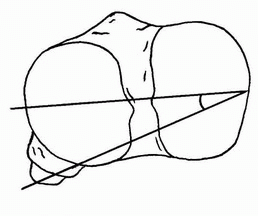Angle of Inclination of Femur (Mikulicz Angle)
A deformity of the hip where the angle formed between the head and neck of the femur and its shaft (Mikulicz angle) is decreased (coxa vara) or increased (coxa valga).
Patients present with a limp and a limb length discrepancy.
Femoral Neck Version
Also known as angle of femoral torsion, angle of antetorsion, angle of anteversion, angle of declination
Femoral neck version is the orientation of the femoral neck in relation to the femoral condyles at the level of the knee when the femur is viewed along the axis of the shaft. In most cases, the femoral neck is anterior to the transcondylar femoral axis (called anteversion). When the neck axis is posterior to the condylar axis, it is termed retroversion.
Birth 30°-40°
Adult: Males, 8°; females, 14° (Normal ranges are very broad.)
















